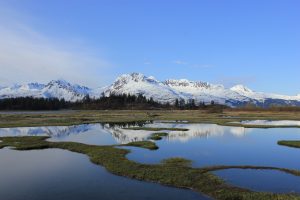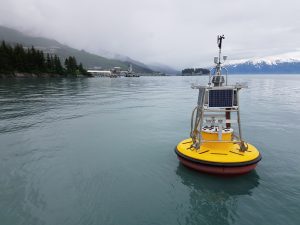
Sensitive areas guaranteed swift protection when threatened by an oil spill
Conflicting views over the timing associated with protecting two areas in Port Valdez in the event of an oil spill has been resolved. Rapid protections for two environmentally sensitive areas, a large salt marsh known as the Valdez Duck Flats and the Solomon Gulch Hatchery, are guaranteed when more than 5 barrels (210 gallons) of oil are spilled from the Valdez Marine Terminal. The protections will also be deployed if a spill occurs and the amount of oil in the water is unknown or if a lesser amount is spilled but the source is not secured.
The resulting agreement also means spill responders will gain important environmental data that will improve oil spill planning and response for Port Valdez.
Diverging opinions led to appeal
In 2017, the Alaska Department of Environmental Conservation, or ADEC, approved an update to Alyeska Pipeline Service Company’s oil spill contingency plan for the Valdez Marine Terminal. One of the changes modified a decision “matrix,” which was a tool created after a 1994 oil spill to help responders decide the timing of when to deploy protective oil spill boom for the duck flats and hatchery, both east of the terminal.
The 2017 version of the matrix potentially delayed protections for these two environmentally sensitive areas. In that version, if the oil was moving west, the matrix did not require immediate deployment of the protections, even in the case of a 2.5-million-gallon spill from the terminal.
Deploying the protective boom takes time, up to 10 or more hours depending on the weather. Based on the Council’s analysis of the 2017 version of the matrix, deployment of the protective boom could have been delayed up to 36 hours.
The Council was concerned that the oil would contaminate the two sites if the incoming tide moved the oil east, which would be expected every 12 hours. The Council appealed this approval, along with the City of Valdez, and the Prince William Sound Aquaculture Corporation. The Valdez Fisheries Development Association filed a separate appeal, but both appeals were eventually joined.
Collaboration leads to consensus
Alyeska, ADEC, and the groups who appealed reached a consensus after a years-long collaborative process.
The compromise called for gathering information about the weather in the vicinity of the terminal. To accomplish this, the groups agreed that a weather buoy would be placed at the Valdez Marine Terminal. The new buoy records wind speed, gusts, and direction; wave height and direction; and current speed and direction.
Preliminary data shows that an easterly movement of winds and waves is common.
Better data on variable weather conditions in Port Valdez

A second weather buoy was placed near the Valdez Duck Flats, co-funded by a grant from the City of Valdez. Both weather buoys were donated to the Council by Fairweather Science.
Compromise means safe oil transportation in Prince William Sound
In over 30 years of existence, this was the first time that the Council appealed a decision by ADEC to this level. The appeal lasted almost three years and the Council considers the result a success for all those involved.
“These may seem like insignificant changes, but they add up,” said Linda Swiss, the Council’s contingency plan project manager. “Part of our job is to make sure minor changes do not become a major problem. We all share the goal of keeping oil out of the water and off the land and to ensure that environmentally sensitive areas are protected should prevention measures fail.”